Intel Haswell-EP Xeon 14 Core Review: E5-2695 V3 and E5-2697 V3
by Ian Cutress on November 20, 2014 10:00 AM ESTGaming Benchmarks
While the last thought on the minds of most Xeon users is related to gaming, we frequently get requests to test gaming performance on Xeons. As a result we strap the Xeon to a regular consumer level motherboard that can support them and add in one or two GPUs to see how they perform and if more cores makes a difference over the drop in frequency. Unfortunately due to the orientation of the PCIe slots on the 2P board, we were unable to test the dual E5-2697 v3 configuration.
F1 2013
First up is F1 2013 by Codemasters. I am a big Formula 1 fan in my spare time, and nothing makes me happier than carving up the field in a Caterham, waving to the Red Bulls as I drive by (because I play on easy and take shortcuts). F1 2013 uses the EGO Engine, and like other Codemasters games ends up being very playable on old hardware quite easily. In order to beef up the benchmark a bit, we devised the following scenario for the benchmark mode: one lap of Spa-Francorchamps in the heavy wet, the benchmark follows Jenson Button in the McLaren who starts on the grid in 22nd place, with the field made up of 11 Williams cars, 5 Marussia and 5 Caterham in that order. This puts emphasis on the CPU to handle the AI in the wet, and allows for a good amount of overtaking during the automated benchmark. We test at 1920x1080 on Ultra graphical settings.
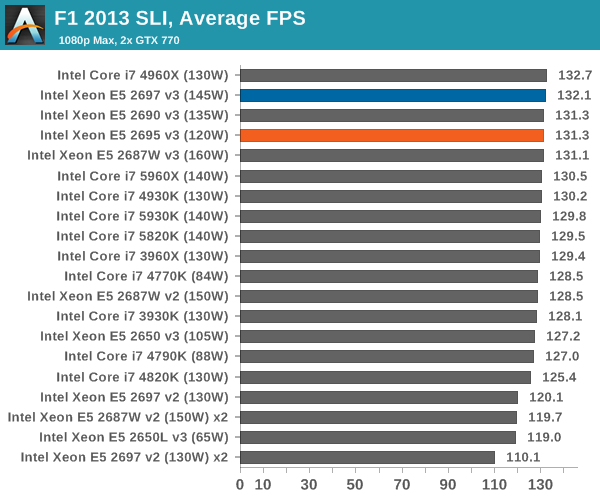
Bioshock Infinite
Bioshock Infinite was Zero Punctuation’s Game of the Year for 2013, uses the Unreal Engine 3, and is designed to scale with both cores and graphical prowess. We test the benchmark using the Adrenaline benchmark tool and the Xtreme (1920x1080, Maximum) performance setting, noting down the average frame rates and the minimum frame rates.
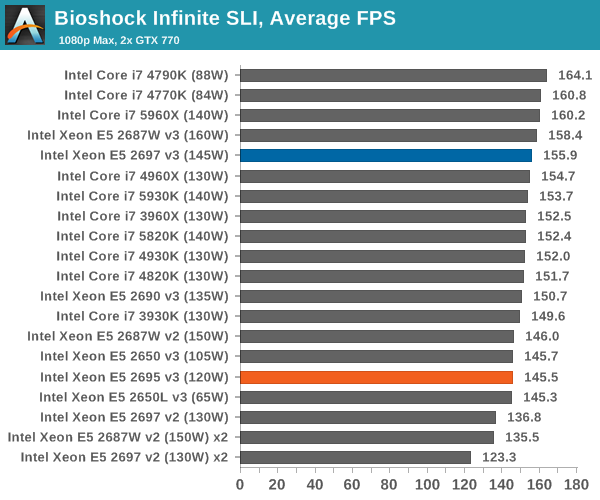
Tomb Raider
The next benchmark in our test is Tomb Raider. Tomb Raider is an AMD optimized game, lauded for its use of TressFX creating dynamic hair to increase the immersion in game. Tomb Raider uses a modified version of the Crystal Engine, and enjoys raw horsepower. We test the benchmark using the Adrenaline benchmark tool and the Xtreme (1920x1080, Maximum) performance setting, noting down the average frame rates and the minimum frame rates.
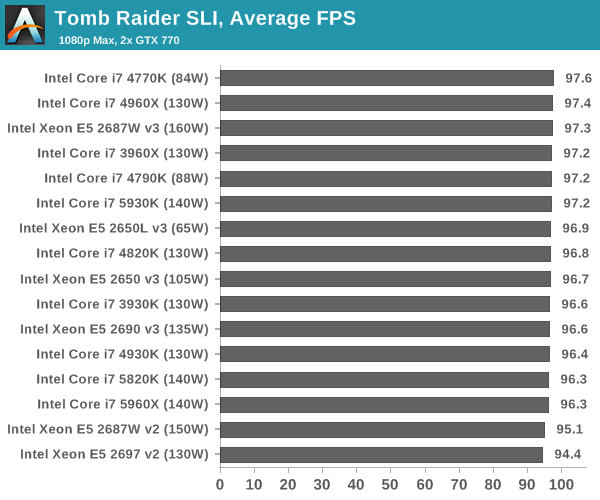
Notice zero results from Tomb Raider from our new CPUs? This benchmark does not seem to like any arrangement above 12 cores per socket, and refuses to run.
Sleeping Dogs
Sleeping Dogs is a benchmarking wet dream – a highly complex benchmark that can bring the toughest setup and high resolutions down into single figures. Having an extreme SSAO setting can do that, but at the right settings Sleeping Dogs is highly playable and enjoyable. We run the basic benchmark program laid out in the Adrenaline benchmark tool, and the Xtreme (1920x1080, Maximum) performance setting, noting down the average frame rates and the minimum frame rates.
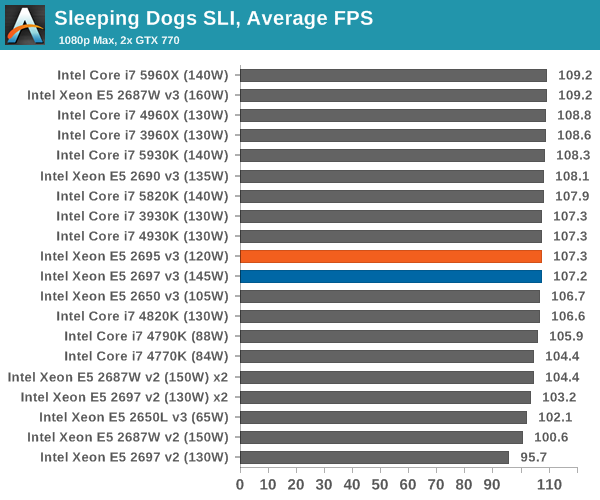
Battlefield 4
The EA/DICE series that has taken countless hours of my life away is back for another iteration, using the Frostbite 3 engine. AMD is also piling its resources into BF4 with the new Mantle API for developers, designed to cut the time required for the CPU to dispatch commands to the graphical sub-system. For our test we use the in-game benchmarking tools and record the frame time for the first ~70 seconds of the Tashgar single player mission, which is an on-rails generation of and rendering of objects and textures. We test at 1920x1080 at Ultra settings.
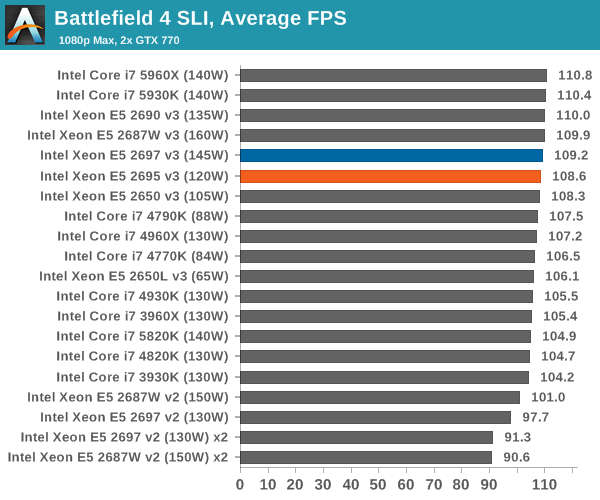















44 Comments
View All Comments
Wolfpup - Tuesday, November 25, 2014 - link
This is awesome :-D I'll never get to touch one of these, even at work, but it's still ridiculous fun to read about them, much less see game benchmarks on them.(Imagine a game actually designed for 18 Haswell cores LOL)
I'd loooove to run Folding @ Home across that many cores!
daresystem - Monday, December 15, 2014 - link
It's interesting, I am actually system builder, so this information is very useful for me. Why you didn't benchmark it with VMWare? I've been using S2600CP for entire my client for year, and I just curious with the performance this processor in real Server usage.Thank you.
jackdgalloway - Friday, June 12, 2015 - link
Regarding the "snoop mode". I got two dual socket, Intel(R) Xeon(R) CPU E5-2697 v3 boxes and found them performing 15% slower on a finite element code than the previous generation dual socket Intel(R) Xeon(R) CPU E5-2697 v2 boxes we had. After much investigation I found the snoop mode was set to early snoop, changing to "cluster on die" sped up the FEA simulation immensely, with that one change the box then outperforming the V2 counterpart by 25%. This was great, however I'm still encountering one problem. I have a monte carlo particle transport code (not a matrix dominant code) whose performance was unaffected by this change, and is still 50% slower than the v2 counterpart. All that said, any intuition on why might be and either troubleshooting thoughts, architecture differences that could cause this, or any other BIOS settings to try?lucien_br - Sunday, March 5, 2017 - link
Xeon V3 with actual game BF1:https://www.youtube.com/watch?v=Faae3_Tdtfw